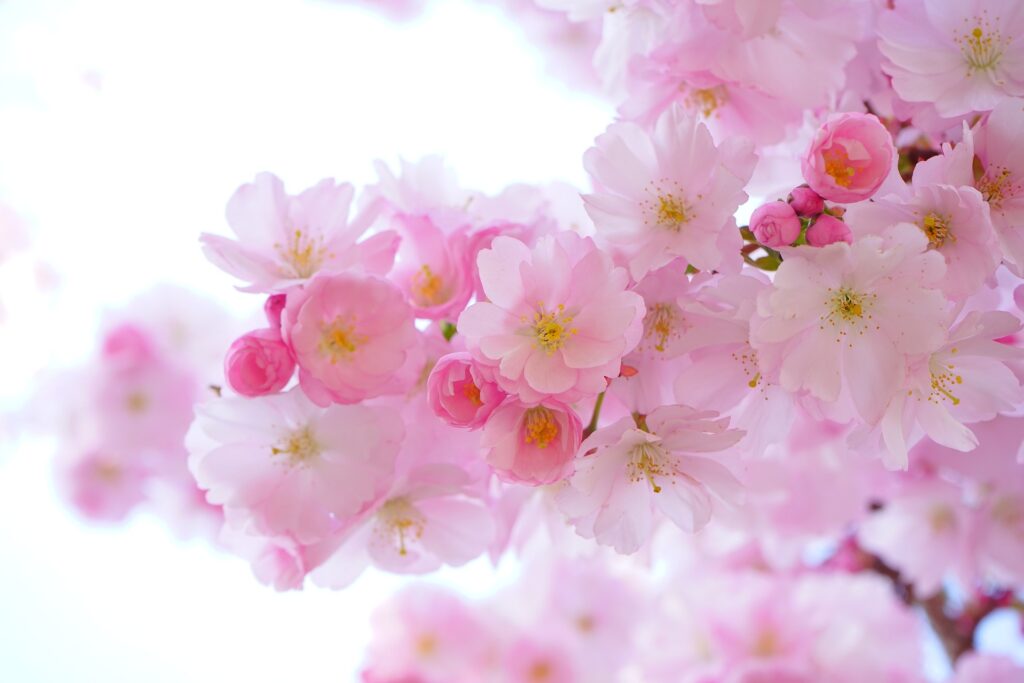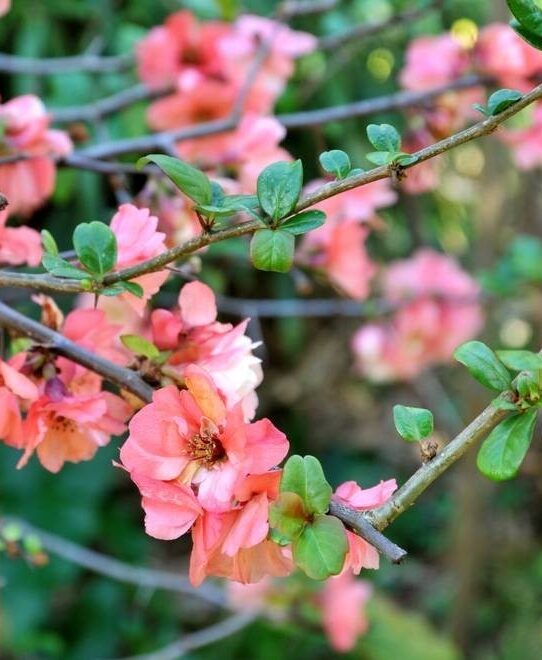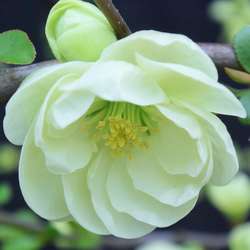
With its beautiful, fragrant late-winter bloom, the Japanese quince ( Chaenomeles japonica ) is one of the earliest shrubs of the year. Its flowering is in this sense a real ode to spring awakening. How to cultivate and maintain this beautiful ornamental shrub ?
Beautiful all year round!
A thorny shrub taking the form of a dense and very branched bush, the Japanese quince can reach two meters in height, as much spreading. Also very hardy, it withstands temperatures down to -25°. It blooms all the more when the winter is cold!
Its deciduous foliage and its alternate leaves, oval, toothed and of a brilliant dark green, are of great elegance. Its flowers, usually simple, brick red or pink, sometimes orange or pink, bloom at the end of winter on brown branches that are still devoid of leaves.
This early, melliferous flowering is one of the first sources of food for pollinating insects, lasting over several weeks, between February and April.
As for the resulting orange fruits, they reach maturity at the end of summer or in autumn. Fragrant and edible, they look like small pears and are smaller than classic quinces. They stay on the branches for several months and are popular with birds.
They can be eaten in jelly, alone or mixed with apples, like real quinces.
Where to plant a cognac from Japan?
Undemanding, the Japanese quince is easy to grow and adapts to all exposures, except for too intense shade, but it flowers more in the sun.
On the other hand, all types of soil suit it, its preference nevertheless pushing it more naturally towards slightly acidic and cool soils. However, it grows perfectly in calcareous soils, even in poor and stony soils.
When to plant a quince tree in Japan?
Plant it preferably in spring or autumn, giving it a few waterings the first year when the weather is dry. On the other hand, it is useless to continue this watering the following years, it supports very well a transient summer drought.
Pot planting
For growing in pots or trays, the ideal substrate is a mixture of 1/3 potting soil, 1/3 compost and 1/3 garden soil.

When and how to carve Japanese quince?
If it is indicated for certain plants, the pruning of the Japanese quince is not really essential. You can indeed let the shrub grow freely, in particular in order to promote its fruiting.
If you nevertheless plan to do so, then it should be pruned after flowering , alternating every other year. Prune for this above the first bud and do not hesitate to severely shorten the branches in order to rejuvenate them.
The Japanese quince also perfectly tolerates strict pruning in June, with a line, allowing it to be used as a separation hedge.
Be careful to protect yourself because the Japanese quince tree is terribly thorny.
Diseases
Relatively resistant and not very susceptible to disease, the Japanese quince nevertheless fears scab, a disease characterized by the appearance of black spots on the leaves. It can be treated preventively with horsetail manure or Bordeaux mixture.
How to use it ?
Robust, Chaenomeles japonica shows excellent adaptability. It resists both urban pollution and coastal spray.
In a shrub bed or hedge, the shrub can be installed alone, on a lawn, or accompany other late-winter flowering shrubs, such as Daphne odora , Edgeworthia , false blackcurrant or even forsythia . . Let it grow freely.
In the smallest gardens, it is also possible, in the ground, to trellis it against a wall to save significant space or to trim it with a line.
The Japanese quince also adapts very well to a culture in a container or in a large pot. It is thus very easy to control its growth and development and to obtain a kind of bonsai that nicely decorates terraces, sidewalks or a Japanese-inspired bed.
How to cut it out of the Japanese cognac?
A heel or crossette cutting is made by taking 10 to 15 centimeters in length from a young side branch at the end of summer. After removing all of the lower leaves and keeping the upper ones, dip the cutting in rooting hormone then transplant it into a light potting soil.
Then place in the stew, covering with a bell. You can repot in a larger pot when it is rooted, making sure to keep it protected from frost during the winter. Then, install the young shrub in the garden the following spring.
What’s the difference between a Japanese cognac and a Japanese apple tree?
Although they have many similarities in terms of their silhouette and their ability to produce edible berries in the shape of apples, the fact is that the Japanese quince and the Japanese apple tree are two very distinct shrubs. . It is true, however, that both belong to the great family of Rosaceae, in the same way as the pear tree. Nevertheless, the Japanese apple tree is truly one of them (Malus floribunda) while the Japanese quince tree seems more of an identity usurper, borrowing its common name from the fruit quince trees (Cydonia family), the shape of its red fruits apple trees!
What’s the difference between a Japanese and Chinese cognac?
Cognac from Japan ( Chaenomeles japonica ) and Chinese ( Chaenomeles sinensis ) are often confused and indifferently called cognac from Japan . To recognize them, however, it is very simple: the first bears thorny twigs while the second does not have thorns.
C.lagenaria and C.superba are also ” cognacs of Japan “. They differ from the real Chaemeles japonica in details: leaf shape, larger dimensions…
There are also many hybrid quince trees: there are almost 500 cultivars. It is thus possible to move away from the classic varieties by choosing, for example, shrubs with double flowers, not unlike the beautiful roses of camellias.
Cognassier of Japan Kinshiden
The Japanese cognac “Kinshiden” is covered with large double, green flowers dotted with notes of cream.
Cognassier of Japan Yukigoten

The Japanese “Yukigoten” cognac produces small double white flowers with a yellow-green heart. Bright, they look like little roses. The shrub is distinguished from other varieties by its “small bush” effect; its height not exceeding one meter. He enjoys the partial shade.
Cognassier of Japan Hot Fire
Perfectly rustic, but also very flowery and branched, the Japanese hot firewood ‘ Chaenomeles speciosa’ is covered with simple bright red flowers with a yellow stamen top. They bloom in February or March on still bare twigs.
Adult, this shrub is about 1.70 m high and 1.50 m wide.
Other more original Japanese cognacs
There are also other varieties with white flowers, such as ‘ Nivalis ‘, or with brick-orange flowers, such as ‘ Unbilicata ‘.
History of the Japanese cognac
The name of the genus Chaenomeles comes from the Greek Chainein (to open) and from melon which designates a fruit. This name was given to the shrub by the English botanist John Lindley who, in the 1830s, studied and created the genus.
Japanese cognac growers had been introduced to Europe a few years earlier from Japan , especially thanks to botanist Carl Peter Thunberg , who spent a long time in the Land of the Rising Sun and helped to make its rich flora better known. For the record, the first Chaenomeles reported from Japan were actually the species native to China!

